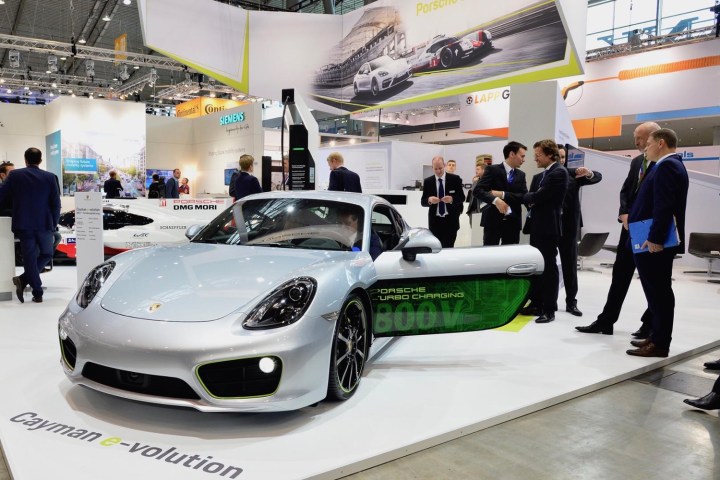
The Porsche Cayman e-volution debuted at the 2017 Electric Vehicle Symposium in Montreal. As the name suggests, it’s a Porsche Cayman sports car modified to run on electric power. Porsche claims it will do 0 to 62 mph in 3.3 seconds, making just over a second quicker than a stock, gasoline-powered 718 Cayman S. The electric Cayman has a range of 200 kilometers (124 miles) per charge, according to Porsche.
The Cayman e-volution won’t go into production; Porsche just built it to demonstrate that electric cars can be sporty. Porsche’s upcoming electric production car will be a four-door sedan based on the Mission E concept that first appeared at the 2015 Frankfurt Motor Show. Porsche claims the Mission E will have a range of 500 kilometers (310 miles), and it’s expected to arrive by the end of the decade.
One feature that will appear in the Mission E was included in the Cayman e-volution. That’s what the company has dubbed “Porsche Turbo Charging.” It’s a fast-charging system that can charge a car at up to 320 kilowatts, making it much more powerful than most current systems. The system will allow the Mission E to charge to 80 percent capacity in just 15 minutes, Porsche says.
It still takes hours to fully charge an electric car using an AC charging station, while DC fast-charging stations like the one Porsche is demonstrating can typically charge to 80 percent battery capacity in 30 minutes. They won’t rapidly charge to full capacity because that could damage battery packs.
A faster charging system could make electric cars a realistic option for more people, but only if there are enough charging stations. Porsche will have to ensure those stations get built, whether that involves building them itself, like Tesla, or by funding work done by third parties, as Nissan has done.
There will certainly be demand for charging stations, as Porsche is far from the only luxury automaker planning a long-range electric car. Corporate sibling Audi will launch its e-tron electric SUV next year, and Jaguar and Mercedes-Benz are planning their own electric SUVs. More electric models will likely follow as automakers work to meet stricter global emissions standards.
Editors' Recommendations
- You can sit in a Porsche (gaming) chair every day for $2,500
- Why charging speed is as important as range for owners of electric cars
- Here’s how Porsche plans to give electric SUVs snow-conquering grip
- You can now buy a Porsche online, but still have to take delivery at a dealer
- Ferdinand Porsche was 100 years ahead of his time with his 1900 hybrid


